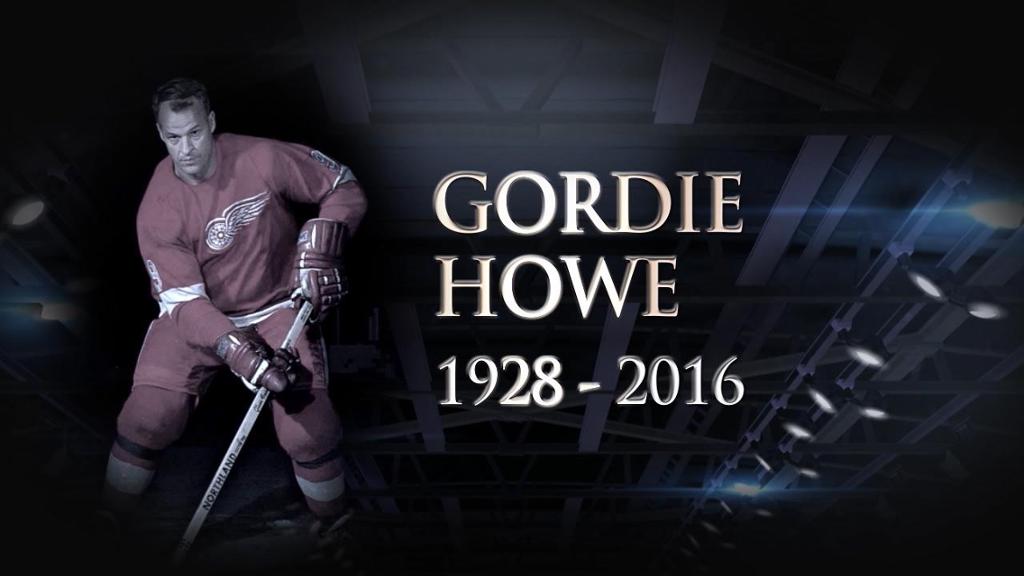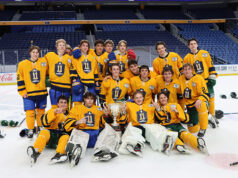Gordie Howe, known as Mr. Hockey because of his accomplishments and contributions to the sport he loved, died Friday. He was 88.
Howe had been diagnosed with dementia in 2012 and had a series of strokes in 2014.
As the only NHL player whose career spanned five decades, Howe played hockey longer and better than just about anyone else who has ever laced up skates. In his League-record 26 seasons, he played in 1,767 games, including 1,687 with the Detroit Red Wings; he holds the NHL records for most games played and most games with one team, respectively.
Howe’s 801 goals were the most in NHL history until Wayne Gretzky passed him in 1994 and remain the most by a right wing. He finished his NHL career with 1,850 points, another record which stood until Gretzky broke it, was the first player in League history to play in 1,500 games, and remains the oldest player to skate in an NHL game (52 years, 11 days).
No one else in NHL history has played past the age of 48.
Howe’s list of achievements leaves him head and shoulders above his peers. He finished in the top five in scoring for 20 straight seasons, helped lead the Red Wings to an NHL-record seven straight regular-season championships (1948-49 to 1954-55), was a member of four Stanley Cup-winning teams, won the Hart Trophy as most valuable player six times, the Art Ross Trophy as the NHL’s top scorer six times, and was given the NHL’s first Lifetime Achievement Award in 2008.
In 1979-80, Howe had 15 goals and 41 points as a right wing for the Hartford Whalers in his final NHL season. Those numbers are hardly paltry, but they were certainly well below the standards Howe had set for himself during his NHL career. Then again, Howe turned 52 years old in the final week of the regular season.
As a result, Howe was for many years the personification and the essence of hockey. His accomplishments, longevity and goodwill as one of the game’s great ambassadors were legendary.
His impressive displays of skill and strength at ages when many players spend their days fishing were matched only by his toughness; Howe’s lone 100-point season in the NHL came in 1968-69, when he turned 41 and when he was assessed 58 penalty minutes.
Such a unique set of accomplishments and such a hallowed place in history is more astounding considering Howe’s early years. Mr. Hockey was born on March 31, 1928, in Floral, Saskatchewan, an unincorporated village so small its last operating post office closed 4 1/2 years before Howe was born.
Floral was not large enough to contain Howe, who was one of nine children, or his family, which moved to Saskatoon shortly after his birth. His humble beginnings in a farmhouse in the small western Canadian outpost wouldn’t hamper his future, nor would the mild dyslexia he suffered from in his youth, or the long hours doctors had him spend hanging from a bar to prevent his spine from curving as a result of a bone condition.
None of these issues was enough to prevent him from becoming a hockey player renowned for his toughness. Howe accumulated 1,685 penalty minutes in his NHL career and had more penalty minutes than points in 11 of his 26 seasons. The Gordie Howe Hat Trick — a goal, an assist and a fight in one game — has become a common term in the language of hockey, though Howe had a mere two of them during his career.
That isn’t to say he was opposed to dropping the gloves. In his book “Gordie Howe: My Hockey Memories,” he noted that at a young age his father taught him a sense of quiet tenacity, telling him, “Don’t let anyone throw dirt on you, because they’ll just keep doing it.” Howe fought so frequently in his rookie season with the Detroit Red Wings that coach Jack Adams famously told him, “I know you can fight. Now can you show me you can play hockey?”
He could.
As longtime rival Maurice Richard of the Montreal Canadiens once succinctly put it, “Gordie could do everything.”
In Detroit, where Howe teamed with Sid Abel and Ted Lindsay (then with Lindsay and Alex Delvecchio) on the famed “Production Line,” he’s still the Red Wings’ all-time leader in goals, points and games played, and is second in assists.
Amazingly, Detroit nearly lost Howe’s rights because he was not properly listed as Red Wings property when he played for the Omaha Knights of the United States Hockey League in 1945. Canadiens executive Frank Selke noticed the error and, having a good relationship with Adams, sent the word along that Howe should be moved to the Red Wings’ protected list. It’s a brief incident that could have dramatically changed the course of Red Wings’ and NHL history.
That year in Omaha, Howe earned $2,500 for the season. In 1946-47, his first season in Detroit, he would earn $7,000, the NHL minimum.
His iconic No. 9 jersey was a product of almost accidental fortune, too. Howe wore No. 17 in his first season with Detroit, but when future Hall of Fame member Roy Conacher, who had worn No. 9, left Detroit for the Chicago Blackhawks after the 1946-47 season, Howe snatched up the now-famous digit. His reason was more practical than stylistic: A lower number gave him a lower Pullman berth on train trips.
The road to that number, which no Red Wings player will wear again, and its Pullman berth was at times a tough one for Howe, who got his first ice skates at age 5 through random chance. A woman trying to make ends meet during the Depression knocked on the Howes’ door offering a bag of clothing for sale. Inside, young Gordie found a pair of second-hand skates that were several sizes too large; he wore extra socks to make them fit.
Howe struggled in school, but hockey was always a constant. He later played for the King George School in Saskatoon in the early 1940s.
Howe was invited to a professional tryout with the New York Rangers in Winnipeg at the age of 15, the first time he saw formal hockey equipment, but New York opted not to sign him. He wouldn’t leave Saskatoon to pursue his career until a year later when he was signed by the Red Wings and assigned to a junior team in Galt, Ontario.
Howe had 48 points in 51 games as a 17-year-old with Omaha in 1945-46, then put up 22 points in ’46-47 with Detroit. His breakout season came in 1949-50, when he finished with 35 goals and 68 points, third in the League. But in the Stanley Cup Playoffs that spring, Howe sustained a fractured skull and a broken nose and cheekbone when he and Toronto Maple Leafs captain Ted Kennedy collided into the boards. The injury required emergency surgery to relieve pressure on Howe’s brain.
Howe returned for the 1950-51 season and won the NHL scoring title by 20 points.
Toughness was a hallmark of Howe throughout his career, not just in his ability to return from injury (he received more than 300 stitches during his career), but in his enthusiastic reputation of a player who worked in the corners and kept his elbows out as a warning to anyone who got close. So well-known was his stance that some came to call him “Mr. Elbows.”
“If you play a little rough, you get respect,” Howe said. “And with respect you get just a little bit more space on the ice.”
Howe announced his retirement after the 1970-71 season because of chronic wrist issues. He declined an offer to serve as the first coach of the expansion New York Islanders, took a job as a vice president with the Red Wings instead, and was inducted into the Hockey Hall of Fame in 1972. A year later, Howe was offered the opportunity to play with his sons Mark Howe and Marty Howe on the Houston Aeros of the World Hockey Association. Gordie had wrist surgery, led the Aeros to the WHA championship, and won the league’s MVP award.
“Once Gordie got drafted by the Aeros, everybody forgot how young Marty and Mark were, how good they were,” Gordie’s wife Colleen wrote years later in “and … Howe!: An Authorized Biography.” “Suddenly the story is ‘Gordie’s comeback.’ It was as if Marty and Mark were tagging along with Gordie instead of Gordie tagging along with them, which is what really happened.”
Gordie, Marty and Mark, who was inducted to the Hockey Hall of Fame in 2011, all moved on to the New England Whalers in 1977. They played together for two more seasons in the WHA before a merger between the leagues brought Howe back to the NHL with the renamed Hartford Whalers, for whom Howe played his last full season in 1979-80.
In “and … Howe!”, Gordie and Colleen revealed his last season in the NHL originally was not intended to be the final one. Howe claimed he approached Whalers general manager Jack Kelley about playing one more season while serving as an assistant coach. According to the Howes, when Kelley declined the offer, a frustrated Gordie quit on the spot and the team called a news conference to announce his retirement the next day. Howe did take one shift with the International Hockey League’s Detroit Vipers in 1997 at age 69 to extend his streak of playing professional hockey to six decades, but for all intents and purposes, his playing career ended in 1980 with Hartford.
Howe was previously told he would have a place in New England “till the roof caves in,” which prompted a frantic demand by Howe to renegotiate when the roof of the Hartford Civic Center collapsed in January 1978.
The way his career ended did not sit well with Gordie and Colleen for years, both because they felt he was forced into early retirement and because Howe left himself few options.
“So he robbed himself of controlling one of the most monumental moments of his life,” Colleen wrote. “I always felt personally robbed of feeling good about the last time Gordie would put on a pair of skates. … He’ll always regret what happened, because he did not want to quit that year.”
Colleen Howe might have been the most famous wife in hockey history. She and Gordie met in a bowling alley in 1950 and were married in 1953. During Gordie’s career, and those of his sons, she represented all three of them. Her assertiveness and fierce protection of her family’s financial interests provided a counterbalance to Gordie, who despite his rugged on-ice persona was relatively quiet away from the rink.
Howe was extremely supportive of his wife’s influence on the business side, once noting, “Girls have more time to think. They’re not whacking each other over the head.”
By the time Colleen died in 2009 at the age of 76 of Pick’s disease, “Mrs. Hockey” was nearly as beloved as her husband.
In addition to his on-ice accomplishments, Howe will be widely remembered for his active participation in numerous charities. The most notable is the Howe Foundation, which Colleen founded in 1993 with the aim of improving the lives of children and helping underprivileged youth learn about and play hockey. They were active in building rinks in Michigan and raising money and awareness for more than 150 nonprofit and charitable organizations in North America, according to the couple’s website mrandmrshockey.com. Their efforts included a 65-city tour in honor of Gordie’s 65th birthday in 1993, during which the Howes thanked fans for their support and raised money for charity, ultimately pulling in nearly $1 million for various causes.
Such tireless work has ensured that Howe will be remembered as much for his off-ice efforts as for what he did in his playing days. Those playing days were immortalized in 2007, when a bronze statue depicting Howe taking a slap shot was unveiled at the entrance of Joe Louis Arena in Detroit. The statue is 12 feet tall and weighs about 4,500 pounds, but it will never cast a shadow quite like the man himself.
(Story and photo reprinted with permission of NHL.com)







